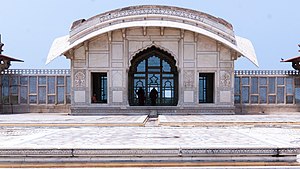Naulakha Pavilion
| Naulakha Pavilion نولکھا | |
|---|---|
 | |
 | |
| General information | |
| Type | Public monument |
| Architectural style | Mughal |
| Location | Lahore, Punjab |
| Coordinates | 31°35′23″N 74°18′47″E / 31.589827°N 74.313165°E |
| Construction started | 1631 |
| Completed | 1633 |
| Design and construction | |
| Architect(s) | Wazir Khan (Lahore) |
| Civil engineer | Abd al-Karim |
The Naulakha Pavilion (
Sheesh Mahal courtyard, in the northern section of the Lahore Fort in Lahore, Pakistan. The monument is one of the 21 monuments situated within the Lahore Fort, with its western façade providing a panoramic view of the ancient city of Lahore.[1]
The structure was originally inlaid with
Pakistani embassy in Washington, D.C.
Etymology
When the
Mughal emperor Shah Jahan as a small summer house, it cost around 900,000 rupees, an exorbitant amount at the time.[2] It is called Naulakha because in Urdu language, the word means 'worth 9 lakhs rupees'.[3] This also brought the word Naulakha into common use to signify something precious.[4]
History


The Lahore Fort was built in 1566 under the rule of
Akbar the Great on the location of an earlier mud-fort. The solid brick masonry complex was later extended and modified by subsequent emperors. Mughal emperor Shah Jahan was a romantic man who constructed Taj Mahal in Agra and after that this master piece in Lahore was built in 1633 as a small summer house costing around 900,000 rupees - an exorbitant amount at the time.[citation needed] Naulakha Pavilion is among the buildings that were erected or reconstructed between 1628 and 1634 under Shah Jahan's rule.[5] Due to his personal interest in the design and construction, Shah Jahan's architectural traditions manifest distinctive symmetry and hierarchical accents. Naulakha Pavilion is part of the Shah Burj block in the northwest section of the fort that was actually built by his predecessor Jahangir.[5]
In 1927, the building was listed by the Department of Archaeology of
British India. In 1975, it was listed as a protected monument under the Antiquities Act by Pakistan's Department of Archaeology, whereas in 1981, as part of the larger Lahore Fort Complex, it became inscribed as a UNESCO World Heritage Site.[6]
More recently, the building and its materials have started showing signs of damage and discolouration due to the
Sheesh Mahal in the Lahore Fort Complex.[7]
Design

Do-chala
style curvilinear roof.The pavilion is rectangular in shape, situated in the west of Agra fort.
Influence
Pakistani embassy in Washington, D.C.
is inspired by the Naulakha Pavilion.As a unique and impressive monument of Mughal architecture,
Numismatics
The Naulakha Pavilion motif was used on the reverse of the
Washington D.C.
is partly modelled on the Naulakha Pavilion.
Gallery
-
Interior of the pavilion
-
A view at sunset of the pavilions carved marble screens
-
Side-view of the pavilion
-
Close-up view
-
Wider view of the quadrangle, minarets of Badshahi Mosque visible in background
-
Inner details
See also
Wikimedia Commons has media related to Naulakha Pavilion.
- Lahore Fort
- Walled City of Lahore
- Badshahi Mosque
- Shalimar Gardens
- Naulakha Bazaar
Notes
- ^ Majid Sheikh (18 July 2015). "Harking back: Exquisite Naulakha Pavilion and its amazing origins". Dawn. Pakistan. Retrieved 7 March 2021.
- ^ Rajput (1963), pp. 8-9
- units.
- ^ Dogar (1995), p. 65
- ^ a b Koch (1991), p. 114
- ^ Khan (1997)
- ^ Syeda Sheharbano Kazim (30 April 2014). "Pietra Dura - an art form passed down through centuries". Dawn. Pakistan. Retrieved 7 March 2021.
- ^ Koch (1991), p. 93
- ^ Asher (1992), p. 180
- ^ a b Lahore Fort Complex: Naulakha Pavilion Archived 14 December 2010 at the Wayback Machine at Archnet Archived 2 May 2008 at the Wayback Machine. Retrieved 4 May 2008.
- ^ Turner (1996) p. 365
- ^ Chaudhry (1998), Asher (1992)
- ^ Khan (1997) p. 117
- ^ Fergusson (1967) p. 304
- ^ Wilber (1964) p. 195
- ^ Kaplan, Robert D. (1989) Lahore as Kipling Knew It The New York Times. Retrieved 7 March 2021
- ^ Kipling (1996). see p.36 and p.173
- ^ Naulakha (Kipling House) in rural Vermont. Retrieved 8 March 2008
- ^ Naulakha Pavilion motif on reverse of One Rupee Pakistani Note in Purple and Blue at Reference Site for Islamic Banknotes. Retrieved 4 May 2008
References
- Asher, Catherine E G (1992) Architecture of Mughal India. ISBN 0-521-26728-5
- ISBN 0-8108-2411-6
- Chaudhry, Nazir Ahmed (1998) Lahore: Glimpses of a Glorious Heritage . Sang-e-Meel Publications. ISBN 969-35-0944-7
- Dogar, Muhammad Aasim (1995) Splendour of Lahore Fort. Ilm Dost Publishers.
- Fergusson, James (1967) History of Indian and Eastern Architecture. Munshiram Manoharlal Publishers.
- Haider, Zulqarnain (1978) Pietra Dura Decorations of Naulakha at Lahore Fort. (Mujallah-e-Taḥqĭq, Kullīyah-e-ʻUlūm-e-Islāmiyah va Adabiyāt-e-Sharqiyah). Faculty of Islamic and Oriental Learning University of the Punjab.
- Khan, Ahmed Nabi (1997) Studies in Islamic Archaeology of Pakistan. Sang-e-Meel Publications. ISBN 969-35-0717-7
- Kipling, Rudyard (1996) Writings on Writing. Cambridge University Press. 241 pages. ISBN 0-521-44527-2
- ISBN 3-7913-1070-4
- Rajput A B (1963) Architecture in Pakistan. Pakistan Publications
- Taher, Muhammad (1997) Encyclopaedic Survey of Islamic Culture. Anmol Publications. ISBN 81-7488-487-4
- Turner, Jane (1996) The Dictionary of Art. Grove. ISBN 1-884446-00-0
- Wilber, Donald Newton (1964) Pakistan, Its People, Its Society. HRAF Press
External links







